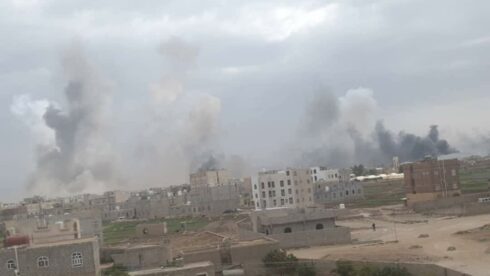Israel launched on May 6 another wave of strikes against the Houthis (Ansar Allah), mainly targeting the Yemen capital of Sanaa.
The strikes came in response to the May 4 Houthi missile attack on Ben Gurion Airport in central Israel. Six people were wounded in the attack which forced many airlines to suspend flights to Israel for days. Later, the group announced that it will be imposing “a comprehensive air blockade” on the country in response to the war on the Gaza Strip.
In an initial response, the Israeli Defense Forces (IDF) struck on May 5 the al-Hodeidah port and a concrete factory near the nearby city of Bajil in western Yemen. Two people were killed and more than 40 others were wounded in the attack. The military released footage of the strikes.
The IDF said that its new attack “completely disabled” Sanaa International Airport, claiming in a statement that the facility was used by the Houthis “for transferring weapons and operatives, and is regularly operated by the Houthi regime for terror purposes.” Aunways, aircraft, and infrastructure were hit at the airport, according to the military
Dozens of Israeli Air Force aircraft were involved in the strikes on May 6, including fighter jets, refuelers, and spy planes, per the IDF.
The IDF also said that it targeted several “central” power stations near Sanaa, which it claimed were used by the Houthis, along with a cement factory in the city of ‘Amran, north of the capital, which it claimed was used by the group to construct infrastructure and tunnels.
The military alleged that the strike on the concrete factory “constitutes a blow to the regime’s economy and its military buildup.”
Before the attack, the IDF issued an unprecedented “urgent” warning to civilians. In a post to the X social network, the IDF’s Arabic-language spokesman, Colonel Avichay Adraee, said, “We call upon you to evacuate the airport area immediately and warn everyone in your vicinity of the need to evacuate this area immediately.”
This was the IDF’s seventh attack on Yemen since the beginning of the war in Gaza, and the second since January of this year.
Israel had refrained from responding to Houthi attacks since the United States launched a large-scale operation against the group in Yemen last March.
So far, the operation has failed to deter the group or to degrade its military capabilities. While the IDF’s attacks on infrastructure in Yemen will worsen the humanitarian situation in the war-torn country, they will not fare any better than the U.S. operation.
_______________________________________________________________________________________________________________________
SouthFront: Analysis and Intelligence
NOW hosted at southfront.press
Previously, SouthFront: Analysis and Intelligence was at southfront.org.
The .org domain name had been blocked by the US (NATO) (https://southfront.press/southfront-org-blocked-by-u-s-controlled-global-internet-supervisor/) globally, outlawed and without any explanation
Back before that, from 2013 to 2015, SouthFront: Analysis and Intelligence was at southfront.com






